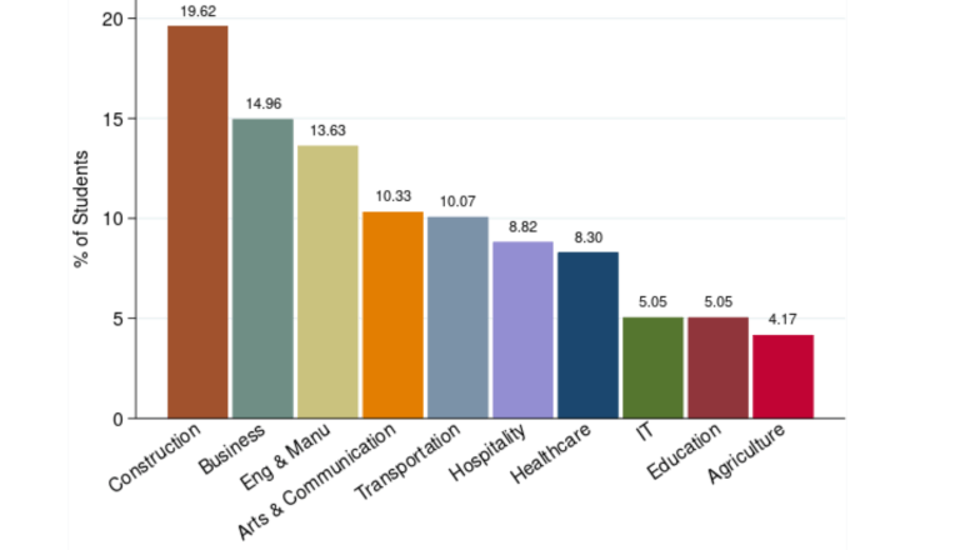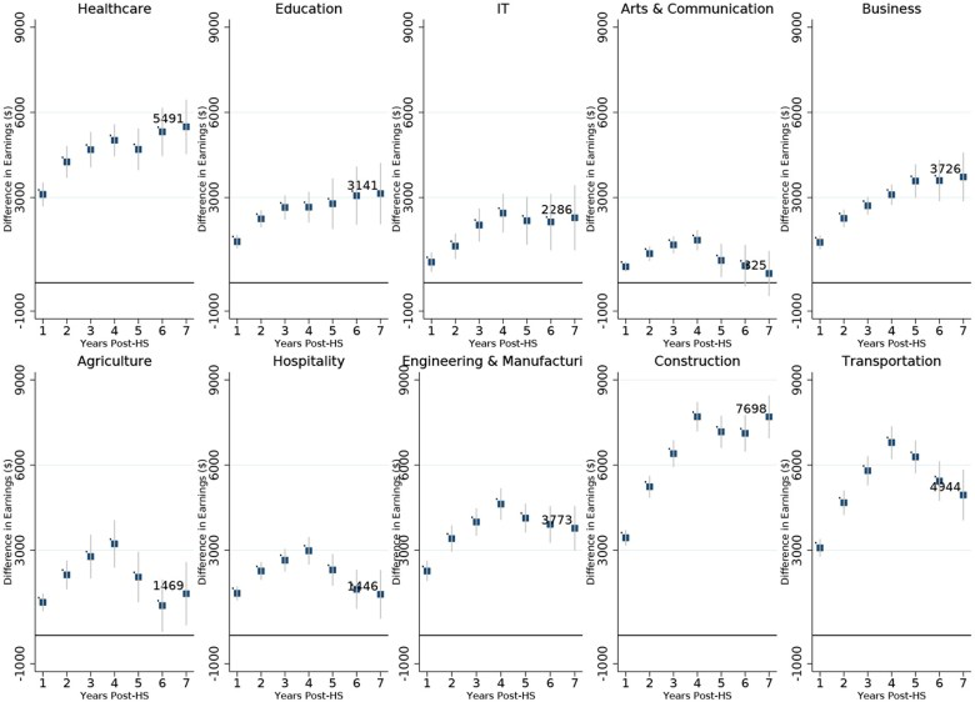Now a pair of academic researchers from Florida State University and Vanderbilt University have analyzed the Massachusetts experiment in career and technical education by following students seven years after graduating high school in 2009, 2010 and 2011. Thanks to detailed school records, the researchers were able to compare students of the same race or ethnicity, family income and most importantly, with the same eighth grade test scores, grades and attendance records. The only difference was that some had career training in high school while others took traditional high school courses.
The biggest surprise was that college going rates were higher for students in five career categories: healthcare, education, information technology, arts/communications and business. For example, 77 percent of the students who specialized in healthcare enrolled in college within seven years of graduating high school. That’s 15 percentage points higher than similar students who had a traditional high school education.
“There’s nursing programs and allied health programs at community colleges that clearly follow after a student’s healthcare classes in high school,” said Walter Ecton, an assistant professor of education at Florida State University and lead author of the study, Heterogeneity in High School Career and Technical Education Outcomes, published in August 2022 in the peer-reviewed journal of Educational Evaluation and Policy Analysis. “Students have a clear pathway and a clear track that they’re putting themselves on.”

Seven years after high school graduation, these career students’ salaries were higher too. For example, healthcare students earned $5,491 more annually than their traditional high school counterparts.
By contrast, college going rates were considerably worse for two career fields: construction and transportation, an area that includes auto repair. Students who specialized in construction fields in high school were five percentage points less likely to go to college than similar traditional high school students.
On the bright side, construction had the highest earnings premium after seven years. Students who studied construction earned $7,698 more annually seven years after high school graduation than similar students who had a traditional high school education. The earnings premium for transportation students diminished from over $6,000 (four years after graduation) to under $5,000 (seven years after graduation) as traditional high school students started to catch up.
“Students who go into construction, they are earning more, at least for the first seven years after high school graduation than we might otherwise expect, and quite a bit more,” Ecton said. “But they’re also much less likely to go to college than we might otherwise expect. I think that that’s a difficult tradeoff. Different students and families and counselors might make different choices here.”
Ecton’s bigger point is that all career and technical education isn’t the same. “We wanted to understand if certain career pathways are paying off more,” he said. “It’s not a simple yes or no answer. It matters which field you’re going into.”

In Massachusetts, every career field showed at least some benefit over a traditional high school education – either in higher earnings, higher college going or both. But Ecton says that’s not a reason for everyone to pursue a vocational high school course of studies.
“For a student who already has very high academic achievement, who is already on a clear path to attending and graduating from a bachelor’s degree program, I think that there’s less clear evidence to suggest that CTE is necessarily going to help those students,” said Ecton.
“I think CTE can be really useful for students who are less engaged in high school in a traditional classroom setting,” said Ecton. “If I were advising a student on whether to be a CTE concentrator or not, one question I would ask is, how else are you going to spend your time if not as a CTE student?”
If the alternative is study hall or a test prep class for struggling students, which Ecton says is often the case, CTE can be more engaging and help expose students to clear options after high school. Ecton highlighted how ninth graders at Massachusetts’ vocational high schools take courses in several career areas, from construction to healthcare to business, getting a taste of many fields before settling on a specialization.
The rosy student experience with career-and-technical education in Massachusetts might not be true elsewhere. The state has a highly educated population with workforce needs in high tech and healthcare. And Massachusetts has invested a lot of money in high-quality vocational programs for high school students. A cost-benefit analysis published in September 2022 determined that the public gains between $56,500 to $113,900 in higher earnings and reduced welfare expenditures for each vocational high school student in Massachusetts. But in Connecticut, the benefits were much smaller — only about $10,000. New Jersey and Delaware run costlier vocational programs and more analysis is needed to see if they are paying off.
Still, even in Massachusetts, the results are uneven. The Pioneer Institute found that one vocational high school in Boston didn’t produce such glowing benefits for students.
“Sometimes in CTE we see a legacy program that’s been around for a very long time,” Florida State’s Ecton said. “But maybe it’s not setting students up for either college or a good paying job right after high school. But we keep those programs because they’ve been here forever. Maybe they’re even popular among students. I would really encourage schools to do this same analysis and make sure they’re seeing at least some positive outcomes in all of their different programs of study for students.”




